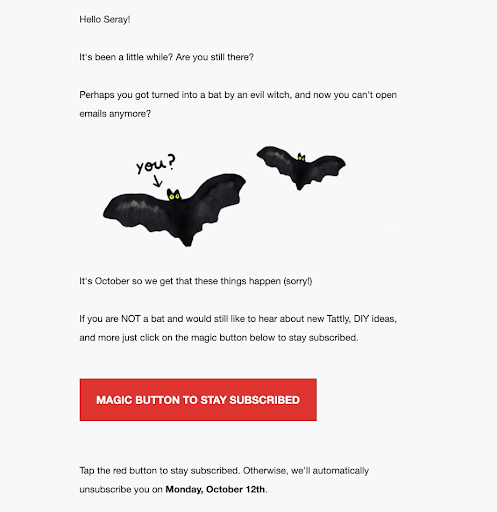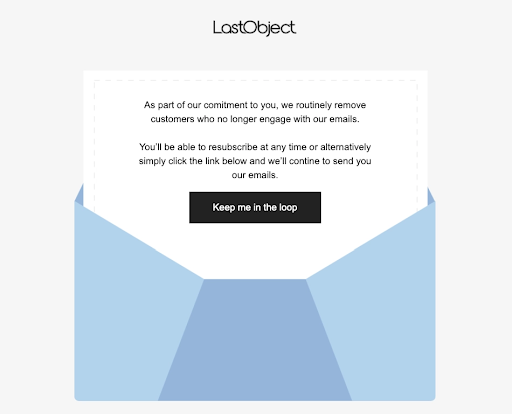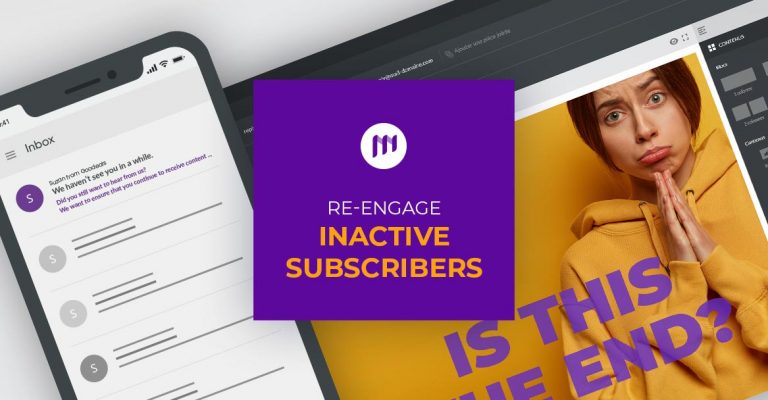5 email ideas to re-engage inactive subscribers
If there is one thing that worries every marketer, it is to see that his email campaigns are never or rarely opened by his subscribers, and this, despite the efforts made on the subject line and the preheader of the email, the writing of the content and the visual used.
The inactivity of your contacts is not a fatality. Not all your inactives are lost. In fact, their presence is a sign that it’s time to draw your secret weapon: re-engagement emails. These campaigns are specifically designed to reactivate your subscribers, to get their attention and generate interaction with your brand, your emails and/or your products.
To help you understand and find inspiration, we’ve selected 5 real-life examples of re-engagement emails that illustrate our tips for getting your inactive subscribers back.
5 campaign ideas to reactivate your inactives
We’ve identified 5 types of messages you can send to reactivate your inactive contacts. We’ve illustrated each type of campaign with several real-life examples to help you find inspiration. You are free to choose just one or to send them all by setting up an automated scenario.
Remind inactives who you are and what they missed
Before jumping to conclusions about the potentially negative opinion your subscribers might have of your brand because of their inactivity, consider the fact that they might not know you well enough.
This is where an email reminding them of your values and your products or services can be timely. It’s an opportunity to remind your subscribers who you are, what your brand is and what you have to offer. It can be a reminder of your strengths, a presentation slides of your latest products or highlighting your latest published articles or a digest of it all.
Follow-up emails like this are a way to remind your subscribers of why they signed up for your newsletter in the first place, without having to offer them a discount or a coupon.
Tip: This type of campaign is more about encouraging than demanding. Do not be too aggressive or commercial in your message. Keep it simple and don’t demand anything from your recipients. If they open your campaign, it is already a first step.
In any case, you need to bring them straight to the heart of the matter: you’re an inactive subscriber, we remind you who we are and here’s what you missed!
Here is an example of this type of email with the Sperry brand, a Canadian brand specialized in online shoe sales.
Here the brand also sends a clear message to its subscribers / customers but does not refer to a preference center.

The campaign overview:
- An effective combination of object and preheader
- Object: We miss you
- Preheader: It’s been too long
- A clear message in three points
- It’s been a long time since you bought from us
- You’ve missed our latest news with a CTA to the latest best items
- Come back for exclusive offers
- A CTA with a wording that may be too aggressive “Buy now” redirecting the user to the store. Prefer an inciting tone for this type of email. It is preferable to go slowly.
- A reminder of the product categories offered
- A focus on social networks to encourage the recipient to keep the connection on another channel if they want to
Offer a discount
Offering a promotional offer to inactive customers is a common practice for e-commerce companies. It”s normal! Everyone likes to benefit from good deals!
An example with the brand Moosejaw which pushes these inactive customers to make a new purchase by offering them a 10% discount on their next order. If this email is intended for inactive customers, it can also be adapted to inactive subscribers.

Take a survey to find out what you need to change
When you notice that some of your contacts are inactive, you can sometimes spend hours wondering why. Isn’t it actually easier to ask them directly?
Turn your contacts’ inactivity into an excuse to get to know them better by sending them a short questionnaire to find out exactly why your contacts are not opening your campaigns, what types of newsletters they would like to receive and thus re-engage your inactive subscribers.
Here is an example from the brand Proven. Although this is an email that was sent after a cart abandonment, it shares many similarities with inactive contact winback emails: a customer liked the brand (enough to create a cart or subscribe to the newsletter), but something prevented them from fully engaging (completing a purchase or opening the emails). So the message can easily be adapted to a campaign to reactivate your inactives.

A re-engagement email asking for feedback from the recipients can also be combined with an incentive to take the survey (discount, gift card, etc.), in order to encourage the most disengaged subscribers to open the email and give their feedback.
The last chance email
Sometimes the easiest way to find out if your contacts want to stay subscribed or not, is to ask them directly. If they do not renew their consent, you can conclude that they want to unsubscribe. Inform your contacts that you will unsubscribe them in X days if they don’t react to this email, but that they can re-subscribe at any time.
Don’t be afraid to ask. Keep in mind that often the fear of losing something is a much more powerful motivator than the prospect of gaining something. By informing your contacts that you are going to unsubscribe them and therefore they will lose their benefits if they don’t react, it will bring some of them to click the “I want to stay subscribed” button.
Below is an example from Tattly.

To summarize:
A touch of humor and a quirky tone in the spirit of Halloween (to fit with the month of October where the campaign was sent),
The situation is succinctly explained and subscribers are told what to do: You are inactive. If you don’t click on the “stay subscribed” button, you will be automatically unsubscribed on such date (or in X days)
It’s simple, easy to understand and nice enough to encourage your subscribers to click on the big red button.
Here is another example from the “Papyrus” brand.

The campaign in brief
- Subscribers are offered two options:
- A button to stay subscribed
- A button to unsubscribe
- A subject line that matches the message
- Subject: Let’s rekindle the friendship 💕
- A reminder of the advantages te benefits acquired via the newsletter
Attention: as a reminder, the GDPR requires the deletion of personal data of contacts who have not interacted with your brand (not purchased a product but also only opened an email) for 3 years. While the idea of renewing consent is a good one, be aware that you will have to unsubscribe anyone who has not reacted within this time limit.
The most important thing in an email like this is to avoid at all costs making people feel guilty about unsubscribing. By keeping the message light, you leave the door open for your subscribers to re-subscribe at a later time, when the time is more convenient for you.
You could also redirect subscribers to a preference center that allows them to choose the frequency of sending and/or the theme of the newsletters.
The unsubscribe email
There you go… You’ve sent your inactives a whole series of re-engagement emails, each with a different angle of approach but some subscribers remain inactive. It’s time to let them go. You can leave the door open by telling recipients that they can re-subscribe at any time.
Be aware that proactively removing your inactive subscribers has several benefits for you:
- A better reactivity and conversion rate
- A decrease in the number of complaints and unsubscribes
- An improvement of the quality of your base
- Better deliverability
Take a look below at the LastObject brand example.

The campaign in a few words:
- A short and concise message explaining why the recipient is now unsubscribed
- The tone used is neutral but does not try to make the recipient feel guilty.
- The campaign includes a CTA allowing the recipient to resubscribe
Showing a little empathy for your subscribers and their overflowing inboxes can be very helpful. There may come a time when your products or services are useful to them again and your brand comes to mind. In this case, leaving on a positive note can make all the difference.
Conclusion
To conclude, remember that while it is essential to try to reactivate your inactive contacts, it is useless and not productive to keep contacts in your mailing lists who have not reacted to your re-engagement campaigns, just to get more subscribers in your contact list. Give priority to the quality of your contacts over quantity. Better one unsubscribed contact than one inactive subscriber. Your deliverability and reactivity rate will thank you for it.

No Comments